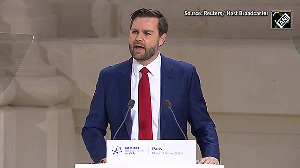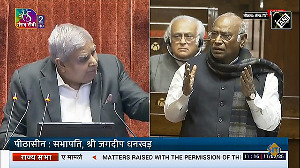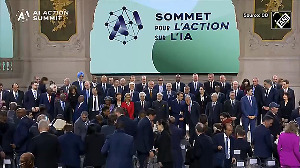Whether we need 'green' technologies -- wind, solar or biomass gasification -- for future energy security is no longer a matter of debate.
The critical question, now is: under what conditions can these emerging technologies be introduced into the market. This answer is not so simple.
Most innovation and manufacture lies with private players. At the same time, the creation of favourable conditions for application is at the door of government and public policy.
Consider also as with any new technology, there will be a learning curve in their application. This learning will have to lead to new innovation, both in technology development and in its practice. There lies the catch.
If we don't get the public-private partnership right, if we don't allow for research, regulation and scrutiny, we will end up nowhere. The technology will be a sham applied for short-term profit, not change.
Take wind energy. For some years now, rightly, the Centre and state governments have given generous fiscal incentives to promote the sector. But does it work? I ask these questions because while crunching government data on wind energy, my colleagues and I got stumped.
By March 31, 2008, wind energy certainly comprised 6 per cent of installed power capacity in the country; yet, we found, it contributed a paltry 1.6 per cent to the actual power generated.
On an average, the plant load factor (PLF, the efficiency at which a wind farm runs based on installed capacity) of wind power installations has marginally increased from 13.5 per cent in 2003-04 to 15 per cent in 2007-08.
Then there are states like Gujarat and Andhra Pradesh, where wind energy PLF is less than 10 per cent. Maharashtra has more than tripled its wind capacity in recent years, but the state government's own data shows wind farms produce less power today than in the past.
In this energy-starved state, wind energy functions at a PLF of 11.7 per cent. It is certainly shocking, compared to global PLF averages of 25-30 per cent.
The fact is that we wanted to promote this technology in the business-as-usual-mode. We did not demand a new working relationship between the public and the private. In fact, we allowed this sector to grow, with the worst characteristics of the market and we continued to pour public largesse.
Currently, the wind energy business is closed, monopolistic and unregulated. It works simply: the turbine-maker (very few in the market) arrange with investor companies to set up wind farms. The same turbine-maker then supplies equipment and is further paid to operate and maintain equipment.
In this completely integrated business, nobody knows the cost of manufacturing a wind-mill. Nobody is interested in reducing costs and increasing efficiency of power generation. As a result, unlike in other parts of the world, in India, the capital and running costs of wind power generation have increased, even though the market dictates the cost decrease with economies of scale.
In this 'closed' economy, there is little public scrutiny, even little public research. The only people, who know anything about the sector, are in its circle of influence -- consultants who get business or business itself. When we researched, not a single wind company was willing to respond to the issues we raised.
Not a single expert was willing to go on record.
This is deadly, when you consider that all new technologies will have their 'learning curve'. The application will have to teach public programmes to be modified and to evolve. In the case of wind, the new policy must promote incentives for generation and reduce subsidy for capital.
It is also clear that if we don't fix the public-private relationship at the beginning, vested interests creep in, get entrenched and make it even more difficult to change.
It is for this reason that only last month, after much delay, government did bite the bullet and agree to a generation- based incentive scheme for wind energy. But it has not modified the existing scheme, which gives incentives for capital and so, this add-on scheme, meant for those who 'choose not to take advantage of capital subsidy and tax depreciation' will clearly lead to little change.
Business-as-usual will continue and the business is not about energy.
We need a new model of technology promotion in all these cases. It has to be 4P -- public-private- public-partnership.
The public regulator has to drive the purpose of technology introduction; private industry must be open and accountable to public funds, which are fuelling its business for public good, and at all stages, public research and public scrutiny must be welcomed and assisted. Let us be clear, green technologies need green politics as well.







 © 2025
© 2025